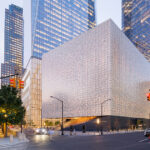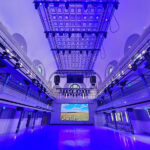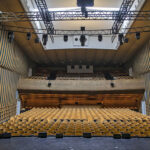The Smith Center for the Performing Arts Opens and Gives Las Vegas a Hall for the Ages
Say Las Vegas, and many things come to mind. Talk about seeing a show in Las Vegas, and a few other things come to mind. What probably doesn’t come to mind is a stand-alone, performing arts center dedicated to serving the local community as a home to the Las Vegas Philharmonic and the Nevada Ballet Theatre, a Broadway touring house, classical music venue, jazz speakeasy and rock or country roadhouse. The Smith Center for the Performing Arts aims to change all that, and to place Las Vegas alongside Vienna, Paris and New York as a city with a world-class performing arts center built for the ages.But to get there the Smith Center, led by President Myron Martin, first had to decide what exactly about Vegas was eternal, and what, in this bright, glitzy, and touristy city was authentic to itself. To help with that process, he brought in Joshua Dachs of the theatre consultancy Fisher Dachs Associates and architect David Schwarz of David M. Schwarz Architects to help the Smith Center board develop their vision.
Timeless and Enduring
“The instruction we were given was that we were to create a building that was timeless and that would look appropriate the day it opened, 50 years from the day it opened, 200 years from the day it opened; one that was not a subject of fashion and that really held its own and was reflective of Las Vegas,” says Schwarz. To define what was essential about Las Vegas the design team turned to the Hoover Dam—a rugged, industrial piece of architecture that not only brought Las Vegas to life (gambling brought the dam workers over from nearby Boulder City, Nev.), but was a piece of design work that was original in itself and not a copy of anything else.
“The other thing that’s most authentic to Las Vegas is neon—and we concluded for ourselves that neon was not the way to go with a performing art center,” jokes Schwarz. “We asked ourselves what kind of a concert hall would the spirit behind Hoover Dam have created, and we think we’ve succeeded in creating that.”
Clean, Muscular
The result is a clean, muscular building with a distinctly art-deco feel, buff limestone walls, and a 16-story bell-tower topped with a stainless steel crown that houses a fully-functional four-octave carillon. Experiencing the space was crafted to be both intimate and impressive, and is laid out to guide visitors through a modulation of spaces—the impressive exterior giving way to human-scaled entryways leading into a majestic lobby, decked in a speckled rose marble, framed and ornamented by stainless steel railings and accents. The lobby, 38-feet high, houses three 18-foot chandeliers that echo the design of the bell tower, a motif that re-occurs throughout the space.
As impressive as all of this is, it almost didn’t happen. The plan for the Smith Center was launched, and the building designed, before the financial meltdown of 2008, back when the real estate market in Las Vegas was hotter than the desert itself and everyone was flush. When the downturn hit, some outside of the Smith Center team questioned if the building should go forward.
Staying the Course
Technical director Tim Sage, a native Las Vegan, still recognizes the courage it took to go through with the building when it seemed the world was falling apart around Las Vegas. “What I admire most about the team, the core people, the founders, the donors—at that time some people would have run the other way and said this is something that we just shouldn’t be doing right now. But our team challenged the attitude of the time, and when everyone else thought they were nuts, put the shovel in the ground and got this building going.”
The Smith Center team also recognized the opportunity in the moment. They had already completed their fundraising, and the downturn meant that suddenly a lot of their design dreams became a lot more affordable.
“We designed it in the old economy, and built it in the new economy,” says Schwarz.
The Center consists of two different buildings: Reynolds Hall, a 2,050-seat European-style opera house, and the Boman Pavilion, which houses Troesh Studio Theater, a 250-seat black-box theatre and the Cabaret Jazz space, a 258-seat jazz performance space.
Reynolds Hall
The mandate behind Reynolds Hall, the centerpiece of The Smith Center, was to build a flexible, 2,050-seat multi-purpose hall that could present anything from the Las Vegas Philharmonic and other symphony orchestras at one end of the spectrum to the best in contemporary amplified music entertainment and touring Broadway productions at the opposite end. Even with all those seats, though, the furthest seat in the house is only 128 feet from the plaster line. They accomplished this by stacking the seating levels—there are five in total—and bringing the seats around in arms to encircle the main floor seating and reach towards the stage.
“It’s designed like a great Italian opera house,” says Dachs. “It has a beautiful horseshoe that wraps around and embraces the stage.”
Blocking Vibrations
But as beautiful as the space was meant to be, it would have been worthless if the sound was horrible, and one of the biggest threats to sound in the hall was the Union Pacific—a branch of the train line runs less than 200 meters from the site of the Smith Center. The presence of the train posed two threats: airborne noise, from the diesel engines and the train horns, and ground-borne vibrations. To ensure that neither of them posed a problem was the job of Paul Scarbrough of Akustiks, an acoustic consulting firm. They performed an extensive noise and vibration study to see how the trains would affect the site, and came up with mitigation measures to ensure they wouldn’t interfere. After working with their special vibration consultant on the ground-borne noise, “mitigation measures” meant tons and tons of concrete connecting the piles the building sits on.
“We determined that if we poured a three-foot-thick concrete slab at the bottom of the hall, that would be sufficiently massive and sufficiently stiff to keep that vibration from being able to create audible noise inside the hall,” says Scarbrough. “And I can say that, having stood on that slab, you never hear a train as it rumbles past outside.” The roof is similarly massive—it’s a 12-inch-thick concrete slab. The plaster ceiling for Reynolds Hall is also hung on springs, decoupling it from the concrete membrane, and ensuring that no vibration gets through.
Dry Air Challenges
After all of that, though, the team also had to consider the fact that the Las Vegas is a desert. The dryer air is more absorptive at high frequencies, so they had to be incredibly stingy in their use of any sound absorptive material in the space. Boxes, which would normally be carpeted, have a terrazzo floor.
“We couldn’t allow that carpeting in Las Vegas,” says Scarbrough. “Even that thin layer of carpeting in what seems like a relatively small area would add a little bit more absorption of those high frequencies and take some of the brilliance of the sound.” Another place they eschewed soft goods? The proscenium valance. Normally a curtain, in Reynolds Hall it’s actually a hard plaster frieze. Scarbrough also worked with Irwin Seating to supply chairs that would minimize the amount of sound absorption. (The aisle caps on the chairs are another location where the Smith Center bell tower logo is incorporated into a lyre motif.)
But the acousticians weren’t done yet. Reynolds Hall also had to support touring Broadway shows and contemporary amplified music. “Symphonic music needs a rich reverberant acoustic character while amplified music needs a very dry crisp articulate acoustic character,” says Scarbrough.
Normally, this would be handled solely by deploying curtains, but the acoustics of the room didn’t support that as the sole solution. After going round and round for a solution, the design team decided on a novel approach, to use the building itself. The antechambers and sound and light locks leading into Reynolds Hall now serve as acoustic baffles. During amplified events the doors leading out of the hall remain open, so the antechambers absorb the sound.
“It’s a very different way of dealing with this,” says Schwarz. “We think it’s incredibly exciting.”
Hard “Curtains”
The stage is 125 feet wide by 53 feet deep, and framed by a stepped proscenium arch that’s 57 feet, 8 inches wide and 40 feet high. The proscenium is unique in that it is not actually solid, but a grill. “The proscenium needed to be fairly acoustically transparent,” says Schwarz. “Which is not an easy thing to do, because you want the proscenium to look solid to the viewer.” The valence of the proscenium is hard plaster, made to look like a curtain, for acoustic reasons as well.
The reason for all of this disguising was to help the orchestra shell couple with the proscenium and get the sound to the auditorium as transparently as possible—and making that happen was not an easy thing.
“When you have a multi-purpose hall, the trick to making it work is to cut the fly loft off to get the stage to couple with the room,” says Schwarz. To get that done in Reynolds Hall, Dachs designed a solid acoustical shell that flies down from the loft space, and seven 40-foot-plus tall towers that roll in from storage at the back of the stage.
The normal problem that this brings up is that the acoustical shell occupies too much space in the fly tower, which can’t be occupied by scenery. Touring shows then have to re-hang their show in a different way, which is not good for them, or the space has to spend the time and money to take down the concert shell and remove it from the building—and everyone ends up dissatisfied with a multi-purpose hall. Josh Dachs and his team came up with an ingenious solution: they hinged the ceiling to the orchestra shell to the back wall of the space. The hinge travels up and down the back wall. When the shell is no longer in use, it hinges to lay flat against the back wall, and then the hinge travels up, taking the shell out of the way and clearing the fly space for scenery. CK Wegner manufactured the shell.
“It’s completely out of your way, which is what you want,” says Dachs. Dachs and his team were also instrumental in laying out traffic patterns backstage and making sure that everything was organized to ensure an easy put in and load out—including amenities like a dock door that leads directly to backstage—with no hallways, elevators or corners to navigate. “So many people will come touring to this building, they don’t have a long time to be familiar with it,” continues Dachs. “The more straight-forward and simple you can make the backstage circulation the better off you’re going to be. And so we’ve ended up with a very, very clear work environment backstage that simplifies the moves from the truck to the stage, from the stage door to the dressing room.”
A Big Rig
The space is laid out well, and it’s also decked out with enough gear to handle the largest productions out there. J.R. Clancy installed 89 one-ton rated counter-weight linesets. “They did a fantastic job,” says Sage. Seven of those are for electrics, and they’ll have a full complement of conventional and automated fixtures: ETC Source 4 ellipsoidals and fresnels, of course, as well as newer gear like Martin Mac Auras, Vari*Lite VL 3500 Wash luminaires and VL 3000 Spots, not to mention 24 new PRG Best Boys. “It’s actually a pretty brilliant piece of equipment I must say,” says Sage, creditng the Best Boy fixture for low amperage and quiet operation. “I love the fact that it’s not noisy to restrike the lamp…I loved the variations of color it produced, I loved the variations of all of the different patterns that could be overlapped and mixed with color in addition to having an even field of light no matter the size of the field. I can use it as a spot, I could use it as a wash fixture and it is quieter than most—which is important in a performing art venue.” The venue uses ETC Sensor dimmers, 868 2.4k, 46 6k, 80 2.4k non-dims and 64 2.4k dim relays from ETC.
For followspots, Sage considered everyone out there, but eventually went with four Strong Super Trouper II’s with 3k lamps. “We put Strong in there because that is the fixture of choice that most of the touring shows are requesting,” says Sage.
In addition to their Best Boys, PRG supplied the rest of the luminaires for the Smith Center. “PRG really rose to the occasion to work with our budget,” notes Sage.
Troesh Studio Theatre
Troesh Studio Theatre in the Boman Pavilion will serve as the black-box space of the Smith Center—even if it is mostly a sage-green room. In addition to being a performance space, it’s also designed to act as a rehearsal room for the Las Vegas Philharmonic and the Nevada Ballet. It’s a 47-foot-wide by 67-foot-long room with a sprung wooden dance floor and a ballet barre and 12-foot-high mirrors running the length of one long wall.
It has a dead-hung ceiling grid with three-foot squares that is 25 foot 2 inches from the floor, and in addition to the usual ETC Source Fours and Fresnels, it contains some pretty sophisticated equipment for a black box space. That’s by design, according to the technical director.
“Realizing that we don’t have a lot of money to continue to throw into labor, I had to think about what made sense to bring in here,” explains Sage. “I started looking at the type of fixtures that would be a good complement to the room, would give us a broad feel, could cover everything from a nice wash down to a narrow spot, and would have the greatest flexibility so I wouldn’t necessarily have to hang and focus conventional fixtures every time there was a new event.”
To accomplish that, he installed some Vari*Lite VLX 3 Washes as well as VL440 Spots. “Doing that simply means that I can bring in the lighting designer, and we can program the fixtures for wherever the stage needs to be moved to,” adds Sage.
Cabaret Jazz
The Cabaret Jazz space, housed in the Boman Pavilion next to Reynolds Hall, is an intimate jazz club that seats 258, with a little more than 200 seats on the main floor, and another 50 seats on the mezzanine that wraps around the space. Two walls of the room have floor-to-ceiling windows, with the stage, 14-feet-deep by 24 feet wide, set against the far end of the room, in front of windows that overlook Symphony Park.
“It’s designed in the grand tradition of supper clubs and hotel ballrooms of the past,” says Dachs. “They’re very quickly going to establish that room as an important venue.”
Seating for the room is very much like a cabaret space, with high cocktail tables and chairs as well as traditional tables on a cherry wood floor. The windows can be covered with microshades and a sage-green draping system to help with sound absorption and block out light when the room is used during daytime events or as a screening room with its deployable screen and Roadster HD18k projector from Christie Digital.
The lighting is primarily static in Cabaret Jazz, dead hung on battens. The front of the house features white powder-coated ETC Source 4 Juniors to blend in with the ceiling, along with LED ceiling luminaires. Most of the fixtures focused on the stage and house are ETC D40 Desire and Lustr fixtures. “They’re great fixtures,” says Sage, who chose them to cut down on the time spent regelling fixtures. He notes the opportunity that now exists to take full advantage of advances in LED technology’s advantages in terms of lower power consumption, “plus great color variations.”
Sage also expresses gratitude for the technical eam he’s assembled at the Center. “I believe that we have perhaps one of the best technical crews anywhere in the country,” Sage says with conviction. “That’s a pretty bold statement, but I do believe that.”
For the Locals
After years of planning, fundraising and building, the Smith Center for the Performing Arts opened with a black-tie gala on Saturday, March 10, and Las Vegas is no longer the largest city in the world not to have a stand-alone performing arts venue.
“When we started this process, the design brief didn’t say ‘build something that looks like a great building,’ the notion was to build a great building,” says Schwarz. “They’re very, very different attitudes, and the client group was incredibly studied, incredibly thoughtful. I think that we all understand the notion of building a cultural center in Las Vegas is deemed by some of the world as being an oxymoron. And that gave us much more of a commitment and need to be careful in the building.”
That commitment and care is evident in everyone who works there, and everyone who talks about the building and what it means to a community more used to putting on shows for tourists than having a place of their own. Finally, and with great flair, they have a hall of their own.
“We’re here, with this state-of-the-art venue, for the citizens of Las Vegas,” says chief operating officer of the Smith Center, Paul Beard.


